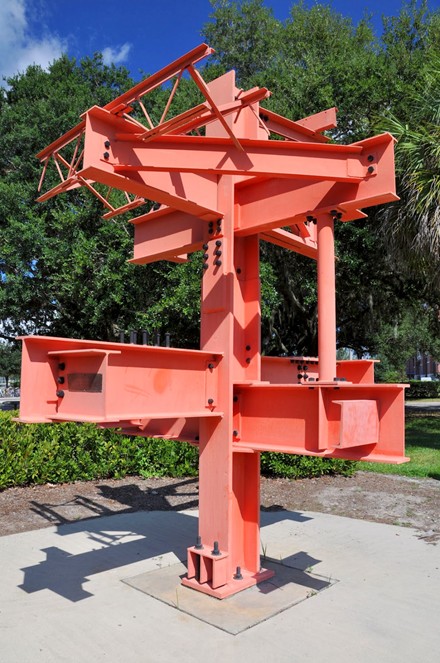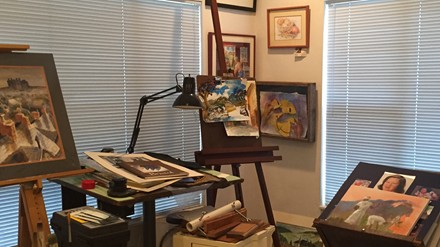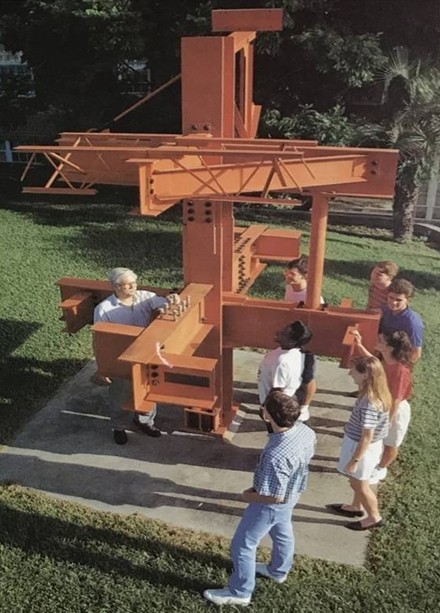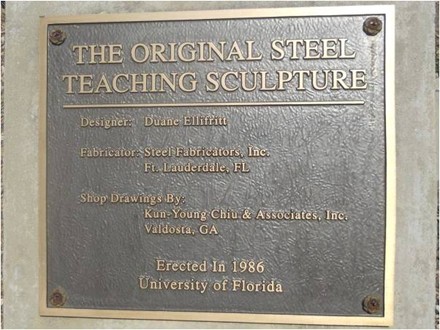MBMA's First Director Of Research And Engineering, Duane Ellifritt, PE, Ph.D. - A Life Of Engineering And Art

| |
Dr. Duane Ellifritt (left), MBMA's first Director of Research and Engineering is shown in this 2006 photo with two of the Directors of Engineering who followed him: Dr. Gilliam Harris (center) and Dr. Lee Shoemaker (right). MBMA has had only four Directors of Engineering in its 60-plus year history. |  |
Duane Ellifritt, a renowned engineer, college professor and artist, and the first Director of Research and Engineering for the Metal Building Manufacturers Association, passed away January 22, 2018. He is survived by Joyce, his wife of 61 years, three children and six grandchildren, and was predeceased by a daughter.
Dr. Ellifritt taught in the Civil Engineering Department at the University of Florida in Gainesville, Florida from 1985 to 2010, retiring with a Professor Emeritus honor. His first teaching position was at Oklahoma State University in Stillwater, Oklahoma from 1970 to 1975. In between, he was the first Director of Research and Engineering for the Metal Building Manufacturers Association (MBMA) in Cleveland, Ohio.
 Throughout his life, Dr. Ellifritt was an avid artist, drawing, and painting whenever possible. His most famous work, the Steel Structure (shown in the accompanying photo), a teaching sculpture, still stands on the Gainesville campus and has been copied nearly 200 times at colleges and universities around the world. Throughout his career, he won numerous awards and accolades and was inducted into the West Virginia Academy of Civil Engineers in 2005. The following year he received the American Society of Civil Engineers’ George Winter Award and in 2013 he was inducted into the Metal Construction Hall of Fame.
Throughout his life, Dr. Ellifritt was an avid artist, drawing, and painting whenever possible. His most famous work, the Steel Structure (shown in the accompanying photo), a teaching sculpture, still stands on the Gainesville campus and has been copied nearly 200 times at colleges and universities around the world. Throughout his career, he won numerous awards and accolades and was inducted into the West Virginia Academy of Civil Engineers in 2005. The following year he received the American Society of Civil Engineers’ George Winter Award and in 2013 he was inducted into the Metal Construction Hall of Fame.
MBMA’s current Director of Research and Engineering, Lee Shoemaker, PE, Ph.D., was invited to the Ellifritt home in Gainesville, FL. There, Dr. Shoemaker interviewed Dr. Ellifritt about his life with MBMA, his teaching career and his love of art. Dr. Ellifritt unexpectedly passed away a few days later. Some excerpts from their conversation follow.
Lee Shoemaker: Duane, you were hired by MBMA in 1975 as their first Director of Research and Engineering. I know you were teaching at Oklahoma State University at the time MBMA contacted you about the position. Tell me a little about your experience and your qualifications that appealed to MBMA.
Duane Ellifritt: I had worked for Armco in their Metal Products Division in Middletown Ohio for 10 years so I had that early experience with designing metal buildings. I thought that I needed more advanced classes in computer analysis with the way the industry was going so I went to the University of Cincinnati to get my Master’s degree part-time. A few years later, I decided to leave Armco and get my Ph.D. at West Virginia University and studied diaphragm research under Dr. Larry Luttrell.
Lee Shoemaker: I know your plan was to teach after getting your Ph.D. in 1970 - how did you land at Oklahoma State?
Duane Ellifritt: Unfortunately, there were very few teaching jobs around in 1970. I put in lots of applications for structural faculty positions. I did get an offer from Oklahoma State University, in Stillwater, OK in the Civil Engineering Department teaching construction. This was not my expertise, but it was the only job offer, so I took it. It was like calculating how many trucks you need to do an earth fill job. Lots of estimating.
Lee Shoemaker: So, after a few years in Stillwater, MBMA came looking for a Research Director. They knew you’d worked at Armco and had metal building experience. You had all the right qualifications and experience at Armco and you had your Ph.D. from West Virginia. That was probably a unique combination that was needed for this new position.
Duane Ellifritt: Yes. In the fall of 1973, Lyle Wilson with American Buildings called me and told me that MBMA was thinking about hiring a person to represent the industry full time and my name had been suggested as a possible candidate. I was not looking to make a change, but the salary sounded attractive, so I met with Lyle and Pete Peterson of Thomas Associates in Tulsa. They took me to dinner and talked about the job. Then about a month later they sent me an offer. Joyce and I talked it over. We thought it would be something fun to do. But it wasn’t the right time.
Joyce was working on her master’s degree in her field and had about another year to finish it. Julia was graduating junior high. So, I wrote Pete Peterson a letter and said thank you for the offer, but I think we’ll turn it down. Then, about a year later, I got a letter from Pete. They’d sweetened the offer a little bit. So, I decided this would be a good time to move if we were going to.
Lee Shoemaker: It doesn’t sound like they had other candidates in mind. They really wanted you.
Duane Ellifritt: When you think about it, there weren’t very many people in the country that had the qualifications they wanted.
Lee Shoemaker: Who would you consider to be a mentor in the metal building industry? Is it someone from Armco, or after you got involved in MBMA?
Duane Ellifritt: I consider Lyle Wilson to be one, and then later on Norm Rimmer with Butler Buildings.
Lee Shoemaker: A lot of people mention Norm Rimmer. He really helped set the culture where there was so much sharing of knowledge and information and lifting up of the entire industry.
Duane Ellifritt: Yes, he knew more about the metal building industry in terms of engineering than anybody. So, I looked up to him. He had me come out to where their factory was, and I got to tour the facility.
Lee Shoemaker: When you came on board with MBMA in the mid-70s that’s when MBMA was getting involved in wind research on low-rise buildings. You probably have a lot of memories working with Dr. Alan Davenport at the University of Western Ontario, and I know Lyle Wilson was very much involved in that program too. What do you recall from those early days of that groundbreaking research with Dr. Davenport?
Duane Ellifritt: It was really easy to work with Alan because he was in London Ontario, right across Lake Erie from Cleveland. And at that time, I think there was a flight or two from Cleveland to London, an early morning flight to get over there and spend the day and get back the same day. He was an easy guy to work with.
Lee Shoemaker: When you took the job with MBMA it was a brand new position and you were trying to figure out exactly what needed to be done and work with the technical committee and the board to promote the industry and to start to develop codes that were appropriate for metal buildings. What do remember as an early code victory?
Duane Ellifritt: Well, of course, wind load is a biggie. We stayed on that for years and years. And then there was something in the concrete industry called thermal lag. It isn’t that they were wrong—it’s just that they were looking at it in a little different way than we were. We did some research with the Midwest Research Institute in Kansas City. They drew up a diagram showing how metal walls if they are well insulated, were even better than concrete with respect to energy efficiency. They asked me to write a paper for the Metal Building Dealers Association and explain to the dealers how they could argue their case.
Lee Shoemaker: You might remember that when I was hired 24 years ago, Chuck Stockinger with Thomas Associates had you come to Cleveland and sit down and talk to me about the job and what it involved. I think Chuck was impressed with how you had handled the job and wanted me to learn from someone that he thought really set the bar for the position. That was very helpful to me and I think is a credit to what people thought of you and what you brought to the industry.
Duane Ellifritt: I remember that. It doesn’t seem like it’s been 24 years though.
Lee Shoemaker: You worked for MBMA for nine years before you left to teach. When did you start to yearn to get back in front of the classroom?
Duane Ellifritt: I always wanted to get back into the classroom. Quite by accident, I ran into my old department head from West Virginia at a meeting in St. Louis. That is when I was working for MBMA. He said, “How’d you like to come to Florida for one semester”? So, here we go all over again. I turned him down the first time. He came back a year later and said they were still trying to fill the position. So, Joyce and I talked it over and decided to do it.
We came to Gainesville in 1982 for one semester. I taught the fall semester in 1982 and then went back to Cleveland. MBMA paid me a little retainer while I was gone to make sure things were running smoothly. It was $200 a month or something like that. So, I went back to MBMA when the semester was over, but the next year he called me up again and asked me if I wanted to do this full time. I thought long and hard about it and decided this would be a good time to do it. I wanted to get back into teaching.
Lee Shoemaker: I wonder if you think that if MBMA had known that it might lead to you leaving, maybe they wouldn’t have been so cooperative in agreeing to let you go for a semester.
Duane Ellifritt: Well, as I recall, the economy was not very good then. Business was bad. So, I think they were kind of glad they saved some of my salary.
Lee Shoemaker: Then they hired Dale Perry after you, right?
Duane Ellifritt: Yes, he worked two years, I guess, and then Gill Harris came after that.
| | 
|

| Dr. Ellifritt's home art studio. |
Lee Shoemaker: The other thing I wanted to talk about was your work as an artist. You were actually recognized in 2006 by ASCE (American Society of Civil Engineers) as the recipient of the George Winter Award that honors structural engineers who have equal concern for technical and social matters, such as art as well as science. Talk a little bit about your lifelong artistic passion and how you managed to combine that with your career that involved so much travel with MBMA.
Duane Ellifritt: Well, I can’t tell you when I first started being interested in art; but as a child, I was always drawing pictures of farm animals and people.
Lee Shoemaker: And you always said you had your sketchbook with you when you traveled?
Duane Ellifritt: Yes. I had several of them. I would draw pictures of people sitting at the airport, for example, and put those together with some other sketches and make a painting out of it.
Lee Shoemaker: And watercolor was the main medium that you used?
Duane Ellifritt: Yes. I went to a lot of workshops with watercolor artists. I’d spend two weeks at a workshop and pick up a lot of good hints.
Lee Shoemaker: Do you have a favorite painting that comes to mind? Something that you really enjoyed doing or that you would consider one of your best works?
Duane Ellifritt: There’s one over there on the wall. (Points to a painting of an airport lobby.)
Lee Shoemaker: Now, another thing that is really a major accomplishment is the structural connections sculpture that you designed and had fabricated at the University of Florida in 1986. It became so popular that many other universities replicated the sculpture on their campus. According to the American Institute of Steel Construction (AISC) website, 178 universities have recreated that sculpture—and not just in the US and Canada, but at engineering schools and universities all over the world.
Duane Ellifritt: The most recent one I heard of was located in Tripoli, Libya.
Lee Shoemaker: You were teaching steel design and thought this would be a great way for students to visualize the connections that you were trying to teach them about. Did this idea just come to you—that it would be a great way to enable them to see all those different connections?

| |
Dr. Ellifritt is shown above with students at the Original Steel Teaching Sculpture that he designed on the campus of the University of Florida in Gainesville. The sculpture's history is described on the plaque below. |  |

| |
Duane Ellifritt: Well, I thought about how people see these connections in three dimensions and I thought maybe I could build a model and put it on wheels and wheel it into the classroom and let them feel it and see it. But that was not very practical. You have to store this somewhere when you’re not using it, and there’d be too many of them. So, I got this idea of creating a sculpture—having all the connections on the same sculpture and put it outdoors where you could see it whenever you wanted to. The university wasn’t terribly interested in it at first.
I had to make a presentation before a campus-wide committee of professors, some of whom were from the arts. I had the dean write me a letter endorsing it, and they finally agreed to let me build it, but they put it around behind the engineering building where it was kind of out of sight. So, I got a steel fabricator to make it and I got the students’ ASCE chapter to build the foundation and platform.
I put in the foundation and poured the concrete slab. Steel Fab of Fort Lauderdale made it, (the sculpture) for me. They shipped it up on a low boy to the campus and we rented a crane. They picked it up and set it over the bolts. I was a little worried about whether they would fit or not but they fit fine. I tightened up the bolts and that thing has been up there for 30 years.
Lee Shoemaker: How did it come to be a model for other schools and teachers? Was it just by word of mouth or did you go out and promote it?
Duane Ellifritt: I made a presentation to an AISC meeting of engineering educators. Several professors came up to me afterward and asked to get the plans. So, I said sure. I mailed plans to anybody who wanted them. Then AISC thought it would be a good thing for them to promote. They thought it would promote cooperation between fabricators and educators. So, they got my plans and scaled it down a bit. My sculpture was 14 feet high. They scaled it down to eight feet.
Lee Shoemaker: And those plans are still available! A university that doesn’t have one can contact AISC and they’ll hook them up with a fabricator and provide the plans as well as an instructional manual to go with it. How many of the sculptures do you think you have actually visited?
Duane Ellifritt: Oh, I’ve probably visited 20. There are 18 of them in Canada.
Lee Shoemaker: Did it serve the intended purpose to help the students visualize the connections better?
Duane Ellifritt: I think it worked well. The thing that was so surprising was that no one ever thought of this before.
Lee Shoemaker: Well, there are a lot of things that we’ve talked about that you should be very proud of. Of what would you say, looking back on your career, that you’re the proudest?
Duane Ellifritt: Well the steel sculpture I guess. Maybe most proud of that.
Lee Shoemaker: And to finish up, what advice would you give to young engineers today?
Duane Ellifritt: In general, I would say to young engineers, “Don’t think you know all the answers. Be flexible. Don’t be afraid to learn something new.”
Lee Shoemaker: And ask questions. Thanks, Duane, for telling us about your early days with MBMA and your amazing career.
Duane Ellifritt: It was my pleasure. It’s fun to rekindle the memories.
About The Metal Building Manufacturers Association
 Founded in 1956, MBMA serves manufacturers and suppliers that work with
industry professionals, architects, building designers, educators,
building code officials and others to advance the metal building systems
industry. The efforts of member volunteers and association staff
regularly lead to industry improvements and groundbreaking research.
Resources on the association's website include technical materials, research reports, videos and design guides, plus news of the most current research and ideas to propel the
industry. MBMA also provides graduate and undergraduate educational
resources at MBMAeducation.org. For more information, visit mbma.com.
Founded in 1956, MBMA serves manufacturers and suppliers that work with
industry professionals, architects, building designers, educators,
building code officials and others to advance the metal building systems
industry. The efforts of member volunteers and association staff
regularly lead to industry improvements and groundbreaking research.
Resources on the association's website include technical materials, research reports, videos and design guides, plus news of the most current research and ideas to propel the
industry. MBMA also provides graduate and undergraduate educational
resources at MBMAeducation.org. For more information, visit mbma.com.